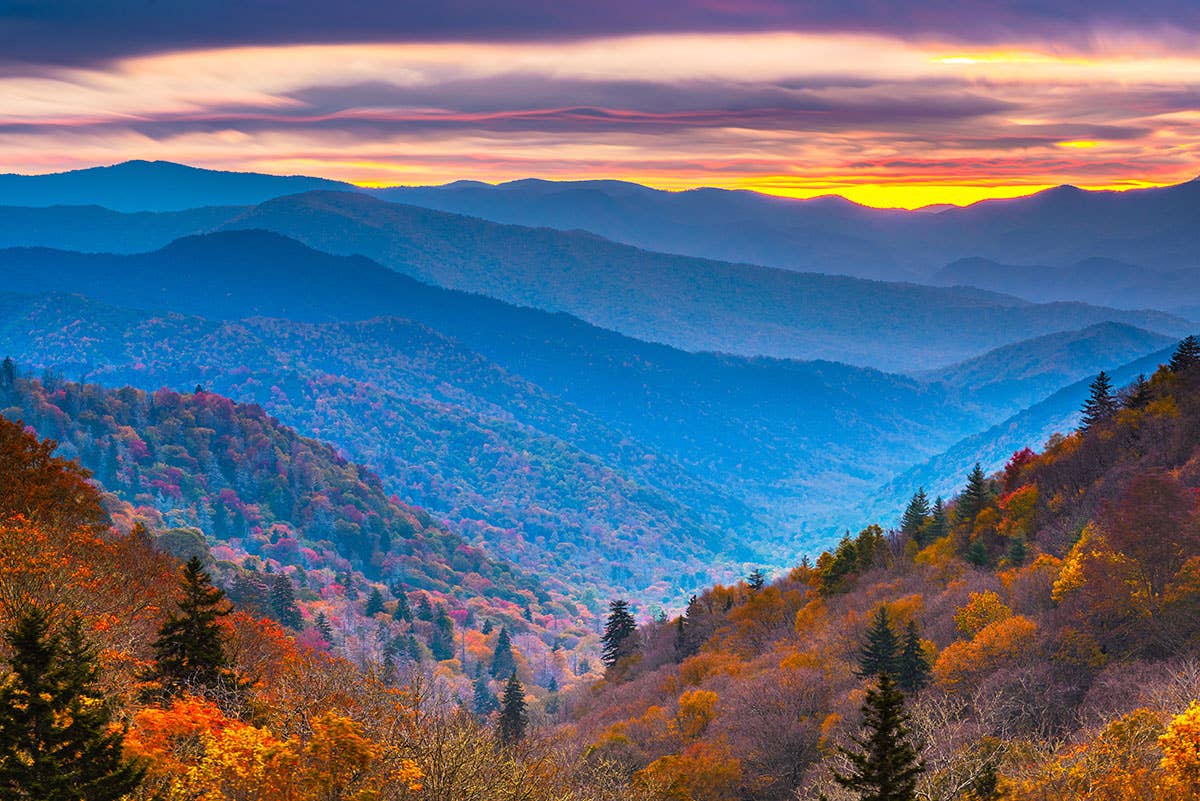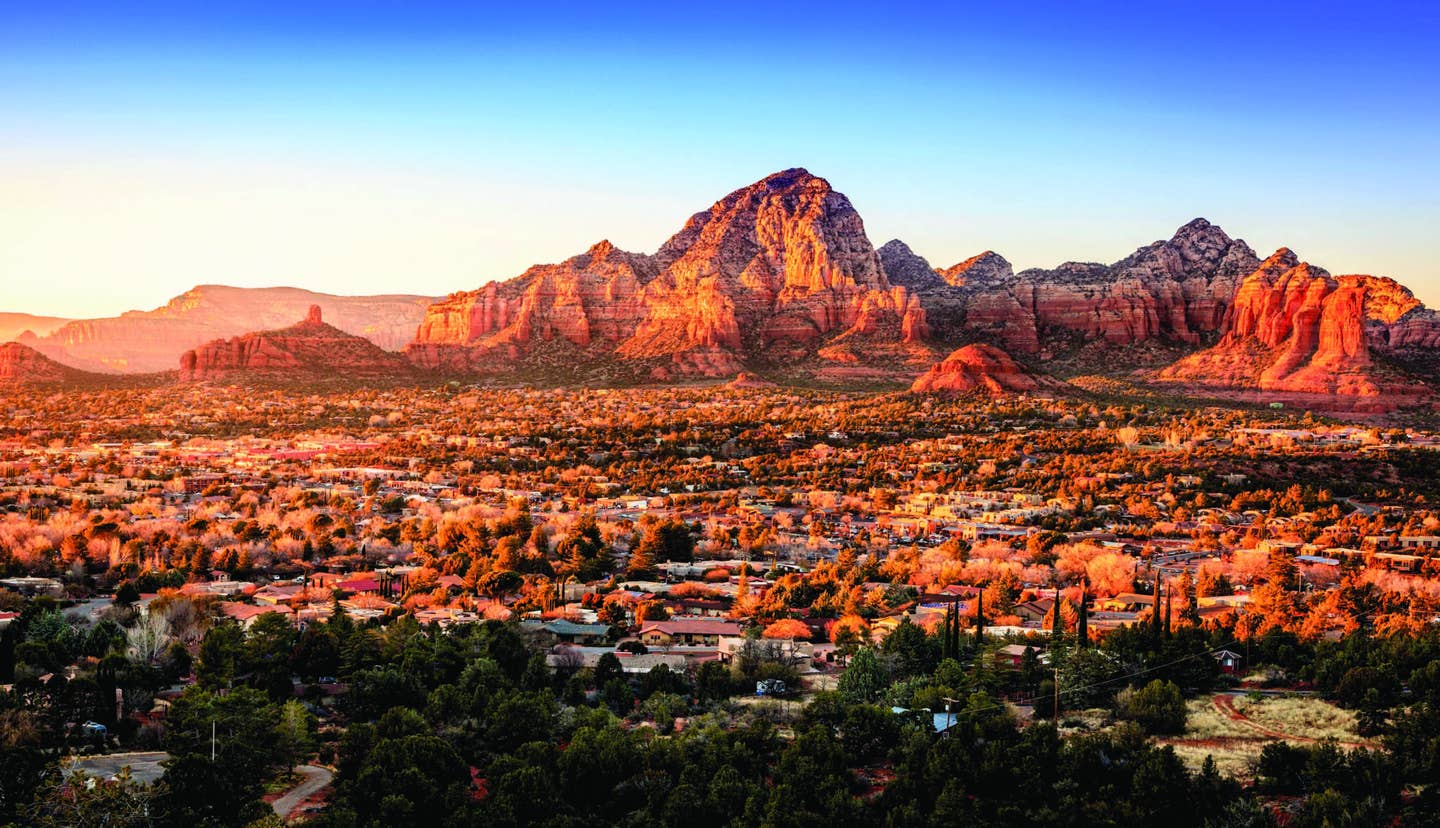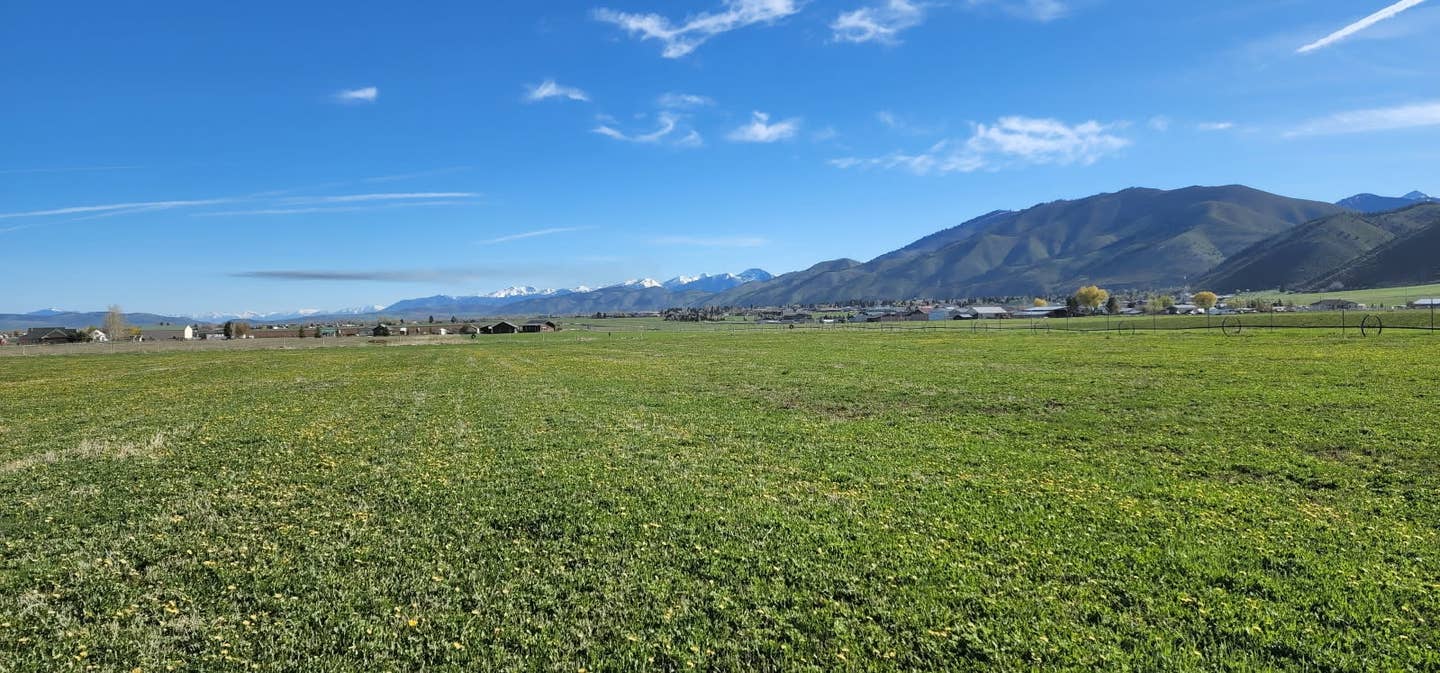The Great Smoky Mountains: A Fly-In That Fills the Senses
Where East Tennessee and West North Carolina collide, you’ll find hundreds of miles of outdoor adventures and attractions to explore.

The Great Smoky Mountains National Park offers visitors a smorgasbord of outdoor activities and is known for its annual display of fall color. [Credit: Adobe Stock]
When you fly into the Great Smoky Mountains region, you’ll find there’s almost no end of things to do. With more than 850 miles of official trails in the national park that shares the region’s name—and many more outside the park’s boundaries—it’s a hiking, mountain biking, and camping haven. A more sedate way to experience the area is to travel the 469-mile Blue Ridge Parkway. One of the nation’s most scenic drives, the parkway’s southern gateway starts in the Smoky Mountains and offers unparalleled views that you can enjoy from the comfort of your vehicle—or aloft from your airplane as you follow along from a respectful altitude (2,000 feet agl over national parks in the U.S.).
For a more thrilling drive on terra firma and an interesting view from the air, travel the 11-mile stretch of U.S. Route 129 called the Tail of the Dragon. Aptly named, the two-lane road carves a jagged path between the Great Smoky Mountains and the Cherokee National Forest near Deals Gap, North Carolina, and gives motorcyclists and sports car enthusiasts 318 curves to navigate—uninterrupted by intersections or structures.
An abundance of rivers and streams in "the Smokies" provide natural swimming holes, tubing, paddling, white-water rafting, and fertile fishing grounds, while its mountain towns and the city of Knoxville offer shopping and attractions, including the world-famous Dollywood theme park.
Flying yourself to the Smokies this time? Don’t miss the Tennessee Museum of Aviation at the Gatlinburg-Pigeon Forge Airport (KGKT). Among the 18 aircraft on display are two P-47 Thunderbolts, a Douglas A-1H Skyraider, a Grumman Albatross, and a Mikoyan-Gurevich MiG-17F. Plan your trip to the Smokies around Knoxville’s Smoky Mountain Air Show (September 10 and 11) and combine the best of aviation and the great outdoors.
The Lay of the Land
Geologists believe the Smoky Mountain peaks started forming between 310 and 245 million years ago, when the North American tectonic plate gradually (a few inches a year over millions of years) sideswiped the African tectonic plate.
The pressures created by the collision contorted once-horizontal sedimentary rocks into the folded and faulted strata that make up the Appalachian Mountain Range of which the Smoky Mountains are a part. The Smokies are some of the oldest mountains in the world and include 16 peaks in excess of 6,000 feet.
The tallest, Clingman’s Dome, stands at 6,643 feet and is the highest point in Tennessee. A half-mile paved hike near the top of the dome leads to an observation tower that provides views of up to seven states on clear days.
Outdoor Diversions
A popular location for outdoor adventurers, the national park includes: a portion of a true hiking mecca—70 miles of the famous Appalachian Trail, which continues north to Maine; 11 waterfalls; four visitor centers; two historic grist mills; and numerous historic family/community burial grounds. The most visited national park in the country, more than 14 million people passed through a portion of its 500,000 acres in 2021.
The park is known for its rich biodiversity that includes the American black bear, about two per square mile; 67 native fish species; 80 types of reptiles and amphibians; and the ever-popular synchronous firefly. One of 19 firefly species in the park, the synchronous firefly gathers by the thousands once a year in a particular campground to put on an unparalleled light show. You can enter a lottery to buy a ticket to the show at recreation.gov. Part of the species’ breeding ritual, the light show usually takes place over an eight-day period in late-May/early June.
Incidentally, the Great Smoky Mountains National Park is an International Biosphere Reserve, a World Heritage Site, and has been called the “Salamander Capital of the World,” given the 30 salamander species in five families that inhabit its waters.
The Dollywood Theme Park in Pigeon Forge, Tennessee, offers an outdoor experience of a different kind. With 50 world-class rides, musical entertainment, seasonal events, dining, lodging—and a waterpark voted in the Top 10 by USA Today readers in 2020—the park is a favorite destination for locals and visitors.
It may be the biggest, but Dollywood is not the only attraction in the area. Nearby, you’ll find Paula Deen’s Lumberjack Feud Show & Adventure Park. Celebrating the history and skill of timber harvesting, the park includes live shows and encourages visitors to participate in ax throwing, speed climbing, and log rolling challenge activities.
At Rowdy Bear Mountain Glider, in Gatlinburg, Tennessee, you can almost take to the air in a single-railed in-air coaster that combines the sensations of free falling and hang gliding. And, if ziplining is your thing, Wildwater’s Nantahala Gorge Canopy Tours in western North Carolina, 10 miles from Bryson City, has 11 zip lines and seven sky bridges that offer views of Clingman’s Dome and Fontana Lake.
A popular winter destination is Banner Elk, North Carolina, a short drive from two top Smoky Mountain ski resorts: Sugar Mountain and Beech Mountain.
On the North Carolina side, Grandfather Mountain boasts a mile-high swing bridge, and Watauga River is famous for its rainbow trout.
The Great Smoky Mountains Railroad provides yet another perspective on this breathtaking landscape with steam and diesel train tours that range from two to four hours roundtrip. The trains leave from Bryson City, North Carolina, and offer different excursions and experiences.
Are you looking to pamper yourself or someone special? Look no further than Blackberry Farm in Walland, Tennessee. This luxury resort in the foothills of the Great Smoky Mountains offers overnight accommodations, fine dining, and a smorgasbord of activities including carriage rides, archery, skeet shooting, horseback riding, paddle sports, paintball, and fly fishing. When you’re ready to relax, the on-site spa provides a variety of massage and facial treatments.
City Scene
From the booming city of Knoxville to bustling mountain towns, the Smoky Mountains have options for city folk too. Visitors can go back in time to 1912 and relive one of the world’s most devastating maritime disasters at the Titanic Museum in Pigeon Forge. The museum, which features costumed cast members in period attire, has more than 400 artifacts from the Titanic on display, which tell the story of the transatlantic cruise that ended in the loss of more than 1,500 passengers and crew.
In Gatlinburg, families have lots of entertainment options. There’s Ripley’s Aquarium of the Smokies, which showcases 10,000 sea creatures and a colony of penguins, unique mini golf courses, and Anakeesta’s Rail Runner Mountain Coaster—the only single-rail alpine coaster in North America. Visitors can also take the SkyLift to the Gatlinburg SkyBridge, a 680-foot-long pedestrian cable bridge that measures 140 feet high at its midpoint.
Into arts and crafts? Travel the Gatlinburg Craft Trail, an 8-mile loop that features more than 100 artists and makers including weavers, carvers, whittlers, potters, candle makers, and more.
In Cherokee, North Carolina, at the southern gateway to the Smoky Mountains, you can try your hand at the slots, blackjack, craps, and other adult games at Harrah’s Cherokee Casino Resort, and hit the greens at Sequoyah National Golf Club.
An hour’s drive from the Great Smoky Mountains National Park, Knoxville is home to the University of Tennessee, the Women’s Basketball Hall of Fame, unique boutiques and big brand stores, and the Sunsphere, a 26-story landmark built for the 1982 World’s Fair. If you’re there on the weekend, be sure to check out the Farmer’s Market at Market Square, where local vendors showcase their fresh-grown produce and meats, and arts and crafts on Saturdays. An historic Knoxville site is the Tennessee Theater, which opened in 1928 and is on the National Register of Historic Places. Considered the city’s earliest skyscraper, the theater hosts concerts, films, and Broadway shows, and is home to the Knoxville Symphony Orchestra and the Knoxville Opera.
Do you have a Brownie or a Girl Scout in your family? Don’t miss visiting the Girl Scout Museum in Knoxville and its archival library of hundreds of years of Girl Scout-affiliated records and artifacts.
For those who enjoy craft beer, you may want to head out on the Knoxville Ale Trail. You can visit 20 local breweries on the trail and mark your progress on a pre-printed Ale Trail Passport. With names like the Crafty Bastard and Barrelhouse by Gypsy Circus, each brewery offers unique flavors, and some also showcase unique wares. For example, the Pretentious Beer and Glass Co. serves its craft beers in hand-crafted glasses and offers glass-blowing demonstrations for those who wish to learn more about that art.
History
Nestled in the Great Smoky Mountains are the vestiges of culture, family heritage, and early communities. From prehistoric Paleo-Americans to early European settlers in the 1800s, the national park has attempted to preserve this history for its visitors.
The history of the park itself is unique. More than 300,000 acres of parkland were purchased with appropriated funds from the states of Tennessee and North Carolina and matched with dollars raised by private individuals and organizations, including the Laura Spelman Rockefeller Memorial Fund. Thousands of small farms and parcels were purchased along with larger tracts. More than 1,200 families moved away from their homes and livelihoods when the park was established in the 1930s. The national park has preserved more than 70 of these vacated original structures—including homes, barns, mills, schools, and churches—and has the largest collection of historic log buildings in the Eastern U.S. Cades Cove, which offers a self-guided walking/biking/driving loop tour, has the largest concentration and variety of these buildings. Settled by Europeans around 1818, at one time Cades Cove was home to 271 people.
At Elkmont, now a national park campground, archeologists have discovered evidence of human occupation that dates 8,000 to 5,000 years ago. Visitors can view the ruins of two early-1900s resorts, the Appalachian Club and Wonderland Hotel, that were developed there. Two buildings used by the Appalachian Club have been rehabilitated for day use.
For more ancient history of the Smokies, visit the Museum of Cherokee Indians and the Oconaluftee Indian Village, a living-history museum, both in Cherokee, North Carolina.

Sign-up for newsletters & special offers!
Get the latest FLYING stories & special offers delivered directly to your inbox






